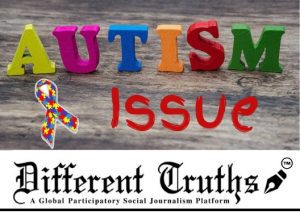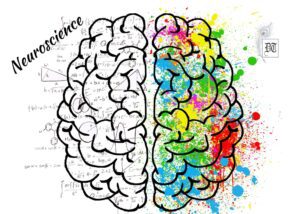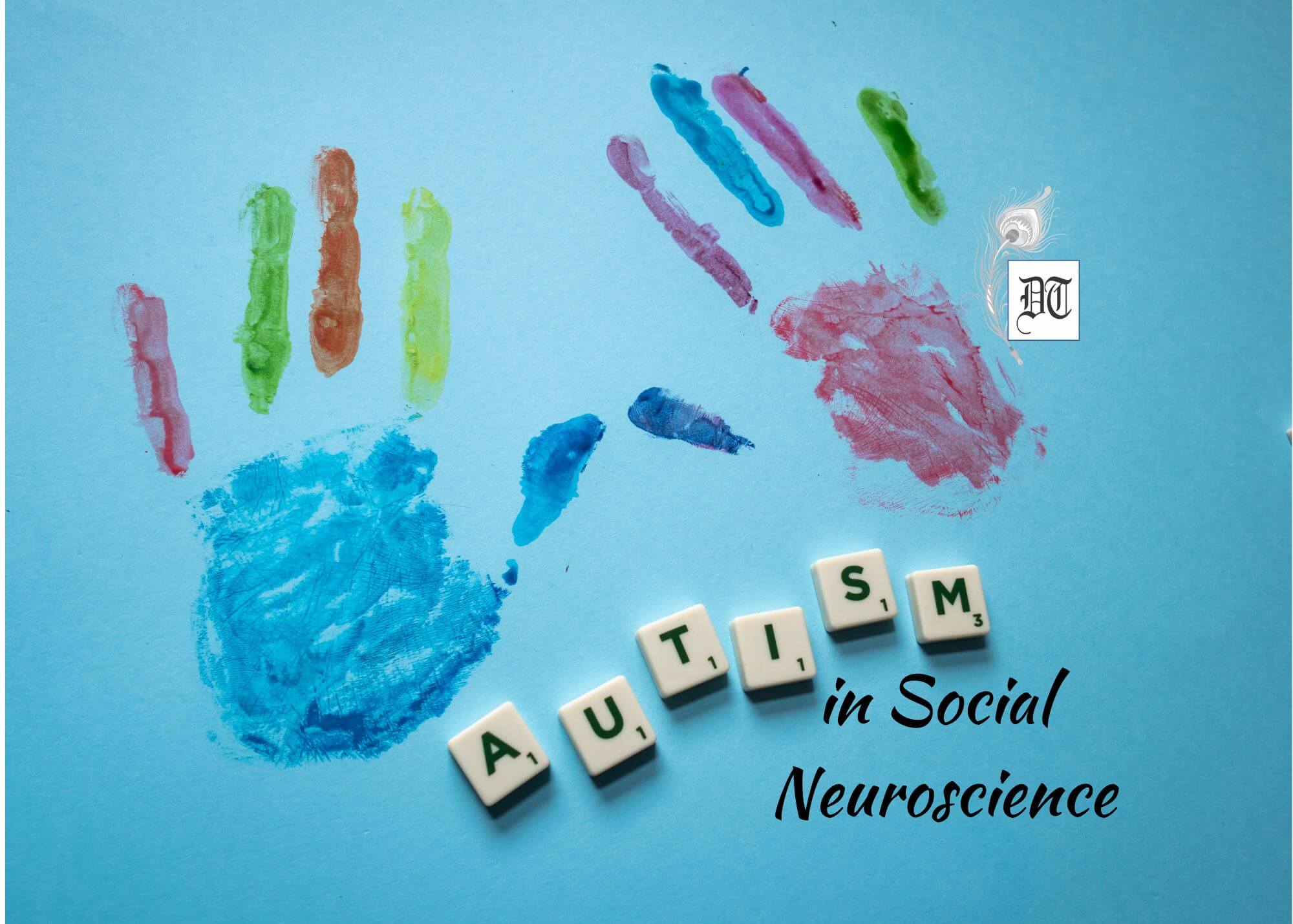Reading Time: 8 minutes
An in-depth analysis of the social neuroscience of Autism, with reference to India with three million cases of ASD, by Nachiketa, for Special Feature. A Different Truths exclusive.
 In the Indian subcontinent, around three million sufferers of ASD (Autism Spectrum Disorder) exist across different strata of society from a rural or urban domain. Till 1980, the majority believed that it is rare and untreatable due to lack of diagnosing centers after awareness has increased the onset of 21 century. Prevalence increment is shown as usual with the western world. Indian prevalence of ASD ranges from 0.15 to 1.01 in various studies (Juneja and Sairam, 2018). Genetic and environmental factors may have a role other than prenatal, perinatal and post-natal risk factors as causal agencies are unknown to autism. In order to identify and diagnose screening for autism is yet to come. Delayed speech, deviance language, including behavioral and social problem are symptoms marked by parents.
In the Indian subcontinent, around three million sufferers of ASD (Autism Spectrum Disorder) exist across different strata of society from a rural or urban domain. Till 1980, the majority believed that it is rare and untreatable due to lack of diagnosing centers after awareness has increased the onset of 21 century. Prevalence increment is shown as usual with the western world. Indian prevalence of ASD ranges from 0.15 to 1.01 in various studies (Juneja and Sairam, 2018). Genetic and environmental factors may have a role other than prenatal, perinatal and post-natal risk factors as causal agencies are unknown to autism. In order to identify and diagnose screening for autism is yet to come. Delayed speech, deviance language, including behavioral and social problem are symptoms marked by parents.
A guideline has been framed by the Indian Academy of Pediatrics in order to screen for ASD. An affiliated tool meant for screening are M-CHAT, ASQ, SCQ, ABC SRC, SCDC. Such tools need validating according to social needs socio-cultural and linguistic norms. Diagnosing evaluation are based on DSM-IV and DSM-V. Tools include ADOS, ADI-R, and CARS. To diagnose autism ISSA is a valid Indian tool. Adult autism status is understudied.
Kanner and Asperger introduced us on clinical syndromes…. Social neuroscience emerged after cognitive neuroscience.
Kanner and Asperger introduced us on clinical syndromes previously for the first time what later established as developmental disabilities of mental health leading to prognosis and relevant. The cultural and political intervention has taken place in order to institutionalise the care for autism and its ability levels of people. Social neuroscience emerged after cognitive neuroscience. On the study of the genesis of neuroscience, studies of the brain hitherto practiced the nonsocial aspects through classic studies of the visual system, executive dysfunction, amnesia and agnosia, the language system in the normal brain. “But such aphasias were lexical or syntactic or semantic and ignored the social aspects of communication” stated Baren Cohen (2005 ). Further argued that assuming “brain-as-a-general-processor” fed by the visual system, or the auditory system, or the memory systems, according to operating principle, ignoring the content value. It was challenged by the case of prosopagnosia and Fodor’s landmark book (1983) on modularity.
Just like a natural scientist, cognitive neuroscientist tried to isolate the variables under controlled condition system working in the social world. Focus on the nonsocial aspects of cognition, and other options were unfolded when Bruner’s (1983) Children mind matters “discovery” of the developing child’s “theory of mind” (Astington, Harris, & Olson, 1988; Wellman, 1990), and in the field of intelligence “social intelligence” or “emotional intelligence” (Goleman,1995) unfolded the “social cognition” (Cited by Barencohen 2005).
The “social brain”, which includes the prefrontal cortex (orbital and medial areas particularly), the superior temporal sulcus, and the amygdala may cause autism
In order to account for nonsocial to the social approach of autism, it took up to 80s when “Does the autistic child have a theory of mind?” (Baron-Cohen, Leslie, & Frith, 1985) indicated specific brain regions or neural circuits that underpinned social understanding. The “social brain” (Brothers, 1990), which includes the pre frontal cortex (orbital and medial areas particularly),the superior temporal sulcus, and the amygdala may cause autism due to an abnormality or deficit condition in one or more of these brain areas what is refereed as “empathising” by Baron-Cohen, (2002). He reviewed the evidence for the normal development of empathising, the role of the amygdala in empathy and the social function of the orbito and medial prefrontal cortex. Elements involve are the ability of mental states to understand agents and appropriate emotional reaction to corroborate other’s mental state leading to conceptualize “Theory of mind”. Cognitive system and universe are related through mental state attribution component which causes intentionality “capacity of something to refer or point to things other than itself” and the effective reaction component is closer to what we ordinarily refer to by the word “empathy”. Empathising starts to develop from early childhood throughout the lifespan “Empathising is a narrowly defined domain, namely, understanding and responding to people’s minds. Deficits in empathising are referred to as degrees of mind-blindness,” in order to support the validity of an amygdala theory of autism.
Kanner emphasised the impairments of social interaction as the cause though he changed his etiology of autistic disorders.
“These children have come into the world with innate inability to form the usual, biologically provided affective contact with people, just as other children come into the world with innate physical or intellectual handicaps,” defined Kanner, 1943. He emphasised the impairments of social interaction as the cause though he changed his etiology of autistic disorders. “Die ‘Autistischen Psychopathen’im Kindesalter” a paper of Asperger, (1944) one year after Kanner’s report (1943) was published. It was debatable on differences between the two disorders in Kanner’s and Asperger’s reports.

The four main themes of contrasts regarding the disorder are as follows: 1) social interaction with others, 2) verbal communications, 3) nonverbal communications, and 4) restricted interests and stereotypic behaviors (van Krevelen, 1962; van Krevelen, 1971) Wing and Gould (1979, cited by Yosuke KITA Toru HOSOKAWA 2011) found out that several autistic behaviors during childhood could be classified into clusters of three similar characteristics: 1) absence or impairments in social interaction with other people, 2) absence or impairments in understanding and using language including verbal and nonverbal communications, and 3) impairments in flexible imagination, and/ or restricted and stereotypic interests and behaviors. These clusters were known as triad impairments and each impairment varied depending on the severity of the disorders and was also related to intellectual functions.
Wing developed the concept of the autism spectrum
Wing developed the concept of the autism spectrum (Wing, 1988, and 1991 cited by Yosuke KITA Toru HOSOKAWA 2011) and mentioned eight common characteristics between the two disorders 1) higher frequency of occurrence in males, 2) aloofness in social relationships, 3) abnormal use of languages (mistakes in the use of personal pronouns and the presence of unique expressions), 4) abnormal nonverbal communication (low eye-contact and the presence of incomprehensible gestures), 5) absence of imaginative play (e.g., pretend play), 6) repeated and stereotypic behaviors, 7) hypersensitivity to sensory stimuli, 8) imbalanced cognitive ability (e.g., some patients had low intellectual ability and excellent memories for machinery), and 9) others (e.g., difficulties in controlled skilled motor behaviors). Wing insisted that the triad impairments were the core characteristics in ASD (Autistic Spectrum Disorder) and that the other impairments might be derived from the triad impairments. Thus, she maintained that there were common impairments between early infantile autism and Asperger’s syndrome and that the differences in the clinical conditions between the two disorders could be interpreted as differences arising from the intellectual ability and the severity of the impairments.
Diagnostic and Statistical Manual of Mental Disorders (DSM) has been used as one of the main diagnostic criteria for developmental disorders. DSM-1 (1952) and DSM-2 (1968) were confusing to define till DSM-3 (1980), clarified operational diagnostic system and criteria (multiaxial diagnostic system) and separated infantile autism as an independent disorder. In DSM-IV (1994, 2000) autistic disorder was diagnosed based on those criteria, which highlights three main clinical conditions: 1) qualitative impairment in social interaction, 2) qualitative impairments in communication, and 3) restricted, repetitive, and stereotyped patterns of behavior interests and activities.
ICD-10 used the term “childhood autism” and “Asperger’s syndrome”.
Additionally, the new criteria make it clear that autistic disorder is not comorbid with Rett’s disorder and childhood disintegrative disorder, both of which were identified as similar clinical conditions around the 1940s. In DSM-IV-TR, “autistic disorder” and “Asperger’s disorder” were recorded in order to diagnose. ICD-10 used the term “childhood autism” and “Asperger’s syndrome”.
DSM-IV-TR, the main clinical conditions to diagnose autistic disorder presence of one condition from the following the triad: 1) qualitative impairment in social interaction 2) qualitative impairments in communication, 3) restricted, repetitive, and stereotyped patterns of behavior interests and activities Whereas, Asperger’s disorder are as follows: 1) qualitative impairment in social interaction, 2) restricted, repetitive, and stereotyped patterns of behavior interests and activities.
The differential diagnosis between autistic disorder and Asperger’s disorder seems to be dependent on whether or not the patient has developmental delays in languages and in cognitive ability.
In other words, the differential diagnosis between autistic disorder and Asperger’s disorder seems to be dependent on whether or not the patient has developmental delays in languages and in cognitive ability. “Pervasive Developmental Disorders (PDD)” includes “autistic disorder” and “Asperger’s disorder” as subcategories and “Rett’s disorder”, “childhood disintegrative disorder”, “subcategories of PDD (F84) in ICD-10 are as follows: childhood autism, atypical autism, Rett’s syndrome, other childhood disintegrative disorder, overactive disorder associated with mental retardation and stereotyped movements, Asperger’s syndrome, other pervasive developmental disorders, and pervasive developmental disorder, unspecified.”
problems exist to measure the severity of ASD due to lack of objective index and acceptance of the concept.
Impact of DSM-5 is still under study. Studies suggest children always or in each case may not at per with the diagnostic criteria of ASD. Young children are the understudied population for diagnostic and overly restrictive with this age group.
Hill and Fombonne (2014) reported estimate for the prevalence estimate of ASD is 66/10,000 although this increase indicates a rise in incidence (“ASD epidemic”) which is debatable, and the reasons are not well understood.
Symptoms in individuals reflect ASD symptoms on a continuum, or spectrum, in mild to severe.
Replacing Autistic disorder, Asperger’s syndrome, childhood disintegrative disorder, and pervasive developmental disorder as PDD of previous edition ASD is now umbrella diagnosis in DSM 5. Symptoms in individuals reflect ASD symptoms on a continuum, or spectrum, in mild to severe.
The DSM-5 diagnostic criteria for Autism Spectrum Disorder include:
- Communication and social interaction failure including disturbed social interaction, abnormal facial expression, eye contact, relationship non-coordination, restricted and repetitive behaviors and interests.
- Childhood developmental failure causes significant impairment in social, occupational and adult maturity.
DSM-5 further describes three levels of severity for symptoms related to social communication and restricted, repetitive behaviors.
- Social communication requires substantial support as little interest are observed in social approach or interaction requiring graded support for restricted and repetitive behaviors.
Symptoms of ASD are manifested within two years, and doctors can often make a diagnosis by age 2. DSM-5, anticipates improvements in later childhood and adolescence.
The neurodiversity movement deals with ethical issues. The notion is that being autism as an inbuilt genetic form so not to be a target of treatment. Suffering, disability, and environmental maladaptation are to be managed.
Disabilities studies suggest the social model be an alternative to the prevalent medical model of autism.
Disabilities studies suggest the social model be an alternative to the prevalent medical model of autism. This model overcomes the exclusion if limited by society due to physical/mental differences. Society defines normalcy as a parameter of at per of mass. Society may act as a disabling agency. The social model filters the idea of normalcy according to its way of seeing.
Waltez (2013) argues, “There is more than one kind of ‘normal’ brain and that as with biodiversity, this may be important for our survival as a species.” Then, “For people with autism, autistic behavior is normal. We need to think carefully about forced normalisation. it damages and develops people, as it does not work. Neurological diversity is simply a part of being human, not necessary.”
ASD is under the Rights of Persons with Disabilities Act, 2016, in order to resist discrimination and to access life support social facilities.
Still, autism is non-curable. Obviously, sufferers can enhance the quality of life through early identification and diagnosis. Early identification is a key factor. Awareness of autism to be implemented as a social event. There should be alertness in health service to provide them required assistance. ASD is under the Rights of Persons with Disabilities Act, 2016, in order to resist discrimination and to access life support social facilities. The Act ensures equalisation of sufferers of autism with a normal population. DMS manual are published as a regular event with clarifications of advantages and disadvantages increasing clauses but specific remedies. Making autistic discounted and marginalised in the socio-economic-cultural periphery is still alive. Here is the problem lies which to be eradicated as the primary concern. Even hoax of lay epidemiology propagates – Vaccination can induce autism. We face the malignancy of society component in this way also. Awareness and education are still the last options.
References
- Juneza and Sairam, (2018) Autism syndrome perspective-An Indian perspective, Recent advances inAutism.www.smgebooks.com
- Simon Baron-Cohen, (2005), Autism and the origins of social neuroscience, Part III Human disorders of social behavior and cognition pp239-254
- Yosuke KITA Toru HOSOKAWA (2011), History of Autism Spectrum Disorders: Historical Controversy over the Diagnosis;東北大学大学院教育学研究科研究年報第 59 集・第 2 号(2011 年
- Fred R volkmarandBrian Reichow, (2013) Autism in DSM-5: progress and challenges Molecular autism. 4;13https://doi.org/10.1186/2040-2392-4-13.
- Hill and Fombonne, (2014), Epidemiology of Autism Spectrum Disorder.
- www.psychologytoday.com/us/conditions/autism-spectrum-disorder.
- Waltez, Mitzi (2013), Autism A Social and Medical History.
Photos from the Internet
















Dr Nachiketa-Thank you for explaining in detail what is unfamiliar till a parent or a family is forced to face it